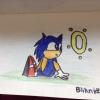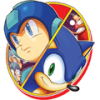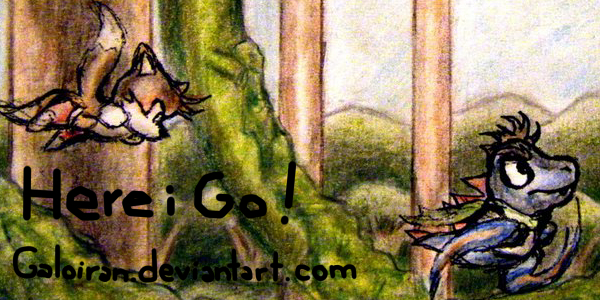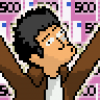Two decades is an eternity in video games, spanning more than half the history of the medium itself. That Sonic the Hedgehog remains a force to be reckoned with after so much time-despite a few trials and tribulations-puts the prickly speedster in elite company. To celebrate its mascot's big anniversary, Sega will tap his entire 20-year legacy for Sonic Generations. The Blue Blur's devoted followers may already know about Generations coming to Xbox 360 and PlayStation 3, but we're pleased to exclusively unveil a unique version headed to the Nintendo 3DS handheld.
The core concept remains the same as in the console offerings, teaming modern-day Sonic-he of the green eyes and lanky frame-with his classic, pot-bellied self from 1991. The time-hopping duo revisits locales from throughout the franchise's history, and each zone comes in two different flavors to reflect our heroes' disparate play styles. With classic Sonic, you get a simplified, platforming-heavy approach akin to his original escapades on the Sega Genesis. That part of the equation holds true for every rendition of the game. But modern Sonic means something different on handhelds than it does on consoles. So whereas Generations for Xbox 360 and PlayStation 3 features 3D gameplay for the present-day hedgehog, the N3DS game follows in the 2D footsteps of Sonic Rush. That makes for a significantly different experience on Nintendo's handheld, and certain fans will no doubt welcome the double dose of side-scrolling action. This take on Generations also deviates from its console siblings with a distinct collection of stages. Only on Nintendo 3DS will you be able to play Casino Night Zone from Sonic the Hedgehog 2, for example.
BLAST FROM THE PAST
The one environment that appears in all versions of the game is the iconic Green Hill Zone. Our demo kicked off with the classic iteration of that stage, which is guaranteed to bring a smile to the face of anyone who sided with Sega during the 16-bit wars.
From the familiar checkerboard pattern to Masato Nakamura's fiendishly catchy theme music, it's like an injection of pure nostalgia; an instant reminder of what made this series so special in the first place.
For many of us, a big part of that is Sonic's original character design. His pot-bellied form has a timeless quality reminiscent of classic cartoons like Mickey Mouse and Felix the Cat, and the way he moves is very expressive, conveying his personality without the need for him to utter a single word. Generations meticulously preserves all of that, right down to the way Sonic taps his foot impatiently (and eventually lies down) if you leave him idle for too long.
The gameplay is slavishly faithful to the Genesis era, as well-to a much greater extent than was the recent Sonic the Hedgehog 4. The physics feel a lot more authentic, providing Sega's fleet-footed mascot with a real sense of momentum, and aside from running and jumping, his only move is the Spin Dash. Sonic even has to hop onto spring pads rather than simply run into them, just like in the old days. Perhaps most importantly, the level design puts as much emphasis on platforming as it does on speed, and that classic formula has aged extremely well.
Though all of the environments come from previous titles, the stages themselves are entirely new in terms of layout. So we're getting a fresh dose of vintage Sonic action for the first time in more than 16 years.
Also new, of course, is stereoscopic 3D. Its use is more restrained here than in modern Sonic's sections (more on that shortly), but the effect really causes the enemies to pop and lends a great feeling of depth to the multilayered backgrounds.
CURRENT AFFAIR
We also went hands-on with the modern iteration of Green Hill Zone, and as touched on previously, it plays a lot like Sonic Rush, or like the Nintendo DS version of Sonic Colors. The action is more kinetic than in the classic stages, pushing you to keep our hero moving as fast as possible at all times. To facilitate that, the Blue Blur has his full repertoire of con- temporary moves. He can grind rails, slide under obstacles, jump off walls, use a homing attack, and collect rings to fill his boost gauge. In keeping with recent Sonic games, the level is also packed with extra "gimmicks" like ziplines and dash pads.
Aesthetically, there aren't any major differences between the two versions of Green Hill Zone, but the modern take on the stage does feature a jazzy remix of the original tune. Jun Senoue and his music team are taking that same approach throughout, crafting modern remixes of classic tracks and vice versa. So in a locale that hails from one of Sonic's Dreamcast adventures, for instance, the modern version of the stagewill feature authentic music and the classic version will get a remix. We've heard only a handful of tracks thus far, but they all sounded fantastic. (For more on the music, check out our brief interview with Senoue in the "Mix Maestro" sidebar.)
As the modern Green Hill Zone winds to a close, Sonic must smash through the bottom section of a ginormous totem pole. The camera swings around in front of the hedgehog afterwards to show the rest of the totem toppling right behind him. It's an impressive spectacle that really highlights the 3D effect, as does modern Sonic's ability to occasionally move between the foreground and background.
The Sonic Rush games have their detractors, but we've always enjoyed this style of gameplay. Don't get us wrong-16-bit Sonic will always reign supreme in our eyes. But having that variety in Generations offers a nice change of pace.
DOCTOR'S VISIT
Our demo concluded with a battle against a giant floating robot dubbed Big Arm. Astute Sonic fans may recognize it as one of Dr. Robotnik's creations from Sonic the Hedgehog 3, which seems to confirm that the bosses will be culled from the Blue Blur's past. The good doctor once again mans the controls, and if you look closely, you can see that he appears in his classically rotund form from the Genesis games. He pilots the craft a bit differently than he did in 1994, though, occasionally rotating into the background and thrusting Big Arm's big fists toward you in 3D.
According to Sega, all of the bosses will be unique to the Nintendo 3DS version of Generations. You'll fight some of them-like Big Arm-with vintage Sonic and others with the present-day hedgehog. Also exclusive to the handheld game are special challenges that you can unlock via StreetPass or Play Coins, as well as a two-player race mode via local wireless. Perhaps the latter will let us settle once and for all which version of Sonic is better. (Our money's on the 'hog with Blast Processing.)
Whatever your preference when it comes to Sega's hasty hero, Sonic Generations seems poised to deliver. After 20 years, pleasing fans both new and old just might be Sonic's biggest accomplishment yet.
Master of Ceremonies
On the eve of Sonic's big anniversary bash, we chat with the man in charge-franchise producer and Sonic Team head Takashi Iizuka—about the hedgehog's past, present, and future.
NINTENDO POWER: What was the inspiration for the core idea behind Sonic Generations-to revisit stages from throughout the history of the series as both classic Sonic and modern Sonic?
TAKASHI IIZUKA: When we started thinking about creating a 20th-anniversary title, we decided that instead of simply releasing another new action game, we wanted to make a game that could only be done on such a special occasion. Once we made that decision, we began to think about how we could condense all 20 years of Sonic history into a single game.
Can you tell us a little bit about the story behind the game and how the two Sonics have come to team up? Does the Nintendo 3DS game follow the same story as the console versions?
A mysterious life form-which is a new enemy in the game-erased time and space, sending modern-day Sonic back to the past. That allowed modern Sonic to meet his own past self. There are some differences in the story between the console and N3DS versions, but they're fundamentally the same.
Why did you want to bring back the classic Sonic gameplay? What do you think it offers that modern sonic games have not?
Recent Sonic titles on handhelds, such as Sonic Rush and the DS version of Sonic Colors, have offered speedy action with the ability to use the Sonic Boost feature. However, they've evolved into a different sort of game than the platform-action Sonic titles of the Genesis era. Of course, we love the Rush and Colors titles, but we're also fond of the tight, single-button, platform-action style of gameplay. In the Nintendo 3DS version of Generations, we've allowed players to play both styles and enjoy their respective merits.
What was the selection process for choosing which stages to revisit?
We discussed it internally, as well as with the staff at Sega of America and Sega of Europe. We also did extensive online research, and conducted polls on which classic Sonic stages were the most popular. From all of that, we made a list of the most popular stages and divvied them up between the N3DS and console versions so that both games would offer a unique selection.
The console versions of the game feature 3D sections for modern Sonic, with the hedge- hog running into the screen, why did you opt for a different approach with the Nintendo 3DS version?
From the start of the project, the concept was to bring Genesis-era Sonic and present-day Sonic together. On consoles, modern-day Sonic is best represented by 3D-action games like Sonic Colors, which switch between side-view and head-on 3D perspectives. On handheld platforms, on the other hand, modern-day Sonic is represented by games like Sonic Rush and Sonic Colors, where Sonic uses the Sonic Boost feature to run at high speeds. That's why we decided to use that style of gameplay for the handheld version.
Who is the director for Sonic Generations on Nintendo 3DS? Is this primarily a Dimps project or are members of Sonic Team working on the N3DS version as well?
The director is Tetsu Katano, who directed Sonic and the Black Knight. [Editor's note: Katano was also the main programmer on the Sonic Adventure titles.] Sonic Team and Dimps are co developing the title.
When it comes to the classic Sonic sections, one thing that hardcore fans are sure to scrutinize is the physics engine. How has the team approached that aspect of the game?
This is our first title on the Nintendo 3DS platform, so we're developing the physics completely from scratch.
Will other characters from the series make an appearance besides Sonic and Dr. Eggman?
The console versions of Generations will feature a large cast of characters, but the N3DS version will only have the ones who are integral to the story.
Many longtime fans are excited to see pot-bellied Sonic back in action. Why do you think there's still so much enthusiasm for that original character design after all these years?
Back in the Genesis days, Sonic the Hedgehog was such a big hit that it even drove hardware sales. The game itself was an industry sensation 20 years ago, and it had a huge impact on many video game fans of the era, myself included. I think there are a lot of people who want to see a continuation of the Sonic games from that era, just the way they used to be.
Last year's Sonic Colors was well received by critics and audiences alike. Did the team take away any lessons from that success?
I think there were a lot of features, such as the Color powers, that were well-received by the audience, and by me, frankly. But in terms of the lesson we considered while making Sonic Generations, I'd have to say that it was making a well-paced action game, in which the pure action experience-rather than the story- is the central focus. That style of game design is reflected in Sonic Generations as well.
Given the success of Sonic Colors, why isn't Sonic Generations coming to Wii?
The primary goal for the console versions of Generations was reimagining the series's classic zones in vivid, high-definition graphics. The Wii hardware wasn't a good fit for that concept, so we abandoned development on that, and decided that for our Nintendo audience, we would make a fresh start with a N3DS version of Generations.
Switching gears to the broader Sonic universe, how is development on Sonic the Hedgehog 4: Episode 2 progressing? Was there any fan feedback from Episode 1 that you're looking to address for subsequent episodes?
We received all sorts of feedback from Episode 1, and are incorporating much of it into the development of Episode 2.
Mario & Sonic at the Olympic Games has been a huge success and another installment is due later this year. Obviously, many fans of those two beloved mascots would also love to see them team up for an action-platformer. Is that something you'd like to see, as well?
It took a huge event like the Olympics to make it possible to bring Mario and Sonic together.
While I'm personally interested in bringing various characters together for a crossover game outside of the framework of a sporting event, I don't think we'll be being seeing Mario and Sonic costarring in a game outside of the Olympics.
You first started on the series way back with Sonic 3. What was that experience like? And was there anything you learned from working with Yuji Naka and Hirokazu Yasuhara that you still carry with you today?
Back then, starting from square one, they taught me everything about who Sonic was and how to make Sonic games, and what Sonic is and isn't about. I've learned so many things from them that if I started listing them all, I might never be able to stop!
Besides yourself and Jun Senoue, is there anyone else still at Sonic Team who contributed to any of the Genesis games?
There are still a few, like Kazuyuki Hoshino, who designed Metal Sonic. Also, Yuji Uekawa, who was the character designer for Ristar, is now the current Sonic illustrator.
What's your fondest memory of working on the Sonic series? And conversely, what was the greatest challenge you had to overcome?
For my fondest memory, well, this may not be the sort of answer you were looking for, but my involvement with the Sonic series has allowed me to see the world. That includes living in the United States, traveling to Europe, and visiting ruins in South America.
My greatest challenge would have to be the development of Sonic Adventure for the Dreamcast. Development of the game over- lapped with the development of the hardware itself, and it was the toughest time we've ever had getting a game finished on schedule. The game was huge, it was being made for a platform that wasn't even 100% finished yet, and it was our first time developing a Sonic game in 3D. To overcome all those challenges, we turned to a number of other departments for help, and by the end of the project we had over 100 people working on the title.
Twenty years is a long time. Why do you think Sonic has endured while other popular characters have fallen by the wayside?
We owe it to the fans that have supported Sonic for such a longtime. For our part, I believe it's because we're always releasing new titles that provide surprises and fresh experiences for those fans.











 Editado por FvG, 24 de noviembre 3400 A.C. - 06:20 PM.
Editado por FvG, 24 de noviembre 3400 A.C. - 06:20 PM.










































